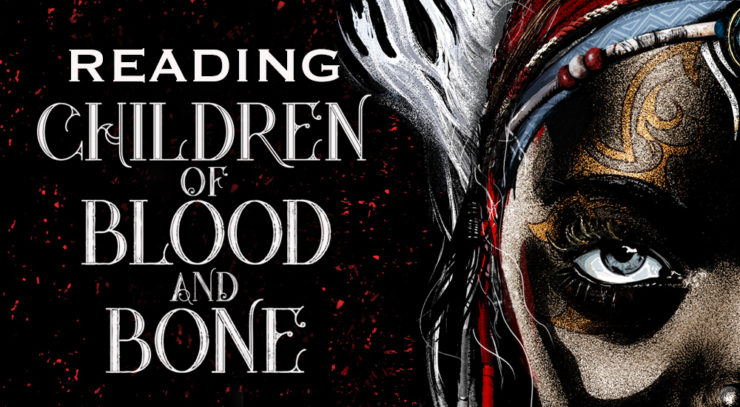Children of Blood and Bone was a hit before it even made it out of edits. Tomi Adeyemi wrote the first draft in just a month. Less than a year later she sold her manuscript and earned one of the biggest advances in the history of young adult fiction. Not long after that, Fox 2000 picked up the film rights for development.
Publisher’s Weekly gave the novel a starred review, stating, “By making tangible the power that comes from embracing one’s heritage, Adeyemi conjures a story that resonates with magic both literal and figurative while condemning apathy in the face of injustice.” The Atlantic beamed with enthusiasm at the story’s Afrofuturist tendencies, noting that “reimagining oppressive pasts and envisioning far-off futures are closely linked revolutionary acts—meditations on the nature of power that can revive the creative potential of speculative fiction.”
Luckily, none of that is hype: the book really is as good as everyone says.
Unlike most YA fantasy books, the default here isn’t Western/European (i.e., fairies, elves, and wizards) but West African. Black Lives Matter, police brutality, and systemic oppression fill the spaces in between. When I reviewed it for Tor.com, I noted that only a Black author could write something like Children of Blood and Bone. Adeyemi’s Blackness—as someone who is Nigerian American but who is often seen and treated as falling under the broader label of African American (a distinction she discusses in some detail in this interview)—is vital here. As I wrote then, “Every hostile interaction between Zélie, Tzain, and the soldiers mirrors the real world experiences and cell phone videos of police brutality. The open disdain of the kosidán toward divîners, of the viciousness of those in power over those who are powerless, of the aggression of those who directly benefit from the system against those the system is structured to disenfranchise.”
Adeyemi has often spoken of the political inspiration for Children of Blood and Bone stemming from her coming to grips with Trayvon Martin’s horrific death, her discovery of Yoruban gods, and her frustration with how angry some white people were at the casting of a Black actor as Rue in The Hunger Games. Although those may seem like disparate issues, the throughline is the degradation of Blackness by the white majority. Our lives, our culture, our very existence in white-dominated society is a political statement, whether we intend it to be so or not. And Adeyemi very much intended it in her series: “I was going to create something so good and so black that even their racist ass was going to see it. That was the dream: that it would be so good and so black and so dark. Not just black, but featuring dark-skinned black people in a way that questions Hollywood’s image of what black people must be and look like.”
Between my day job as a high school librarian, my work for Tor.com, and my book blog, I read a lot of diverse YA science fiction and fantasy. Like, a lot a lot. So it should be no surprise that Children of Blood and Bone was one of my favorite books of 2018. It has everything: action, adventure, high fantasy, gods, vengeful rebels, evil rulers, steamy romance, social commentary, and so much more.
When I was asked if I’d be willing to do a reread of Children of Blood and Bone in anticipation of the release of second book in the Legacy of the Orïsha series, Children of Virtue and Vengeance, I jumped at the opportunity. Given everything I’ve just written about the book, how could I not want to go back through it, teasing out its layers and details with a fine-tooth comb?
This reread will be split up into eight sections covering roughly ten chapters a piece. Each will include a summary of the chapters and my Very Important Thoughts about what’s going on and the socio-historical context in which the story takes place. We’ll be talking racism, colorism, sexism, colonialism, African folklore, Black history, toxic masculinity, and privilege, so be ready y’all. There may be spoilers as well, as I examine the beginnings of events that take place later in the book, so be warned. Children of Virtue and Vengeance is currently scheduled to be released on June 4th, so for those following along, I’ll also be reviewing that book, too! Watch this space.
I’m super excited to squee about Children of Blood and Bone for the next eight weeks. We’ll get started next Monday, February 18th with an in depth look at chapters 1 through 8. Zélie and I hope to see you there…
Alex Brown is a YA librarian by day, local historian by night, pop culture critic/reviewer by passion, and an ace/aro Black woman all the time. Keep up with her every move on Twitter, check out her endless barrage of cute rat pics on Instagram, or follow along with her reading adventures on her blog.










